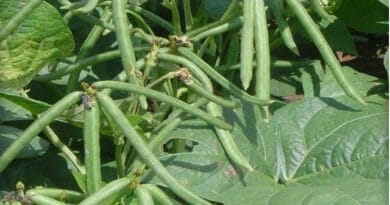Direct-seeded rice ; A technique to Address Production and Sustainably
Direct-seeded rice: A Boon for Rice Production and Sustainably;
The demand for rice is expanding. According to predictions, rice production is expected to increase by 25% over the next 25 years to meet world demands. We must produce this excess rice more efficiently using less labor, water, energy, and agrochemicals to mitigate the environmental impact of rice production and sustainably address this issue.
Rice consumes approximately 40% of global irrigation water, and it accounts for 25 to 30 percent of total irrigation water withdrawal worldwide. In Asia, irrigation consumes over 80 percent of the available freshwater resources, with rice irrigation accounting for more than half. The water required to produce 1 kilogram of rice varies from 1500 to 5000 liters, with an average of around 3000 liters.
Climate change-induced water constraint, combined with competition from urbanization, makes this traditional rice production approach unsustainable in the long term. When combined with additional obstacles like labor shortages and shrinking agricultural land, new ideas and innovations in rice cultivation are critical to complying with rising demand and promising food security.
Direct-seeded rice is one technique to address these issues. Direct seeding is a crop establishment practice in which rice seeds are put directly into the field, as opposed to the usual method of growing seedlings in a nursery and then transplanting them into flooded fields.
What is direct-seeded rice (DSR)?
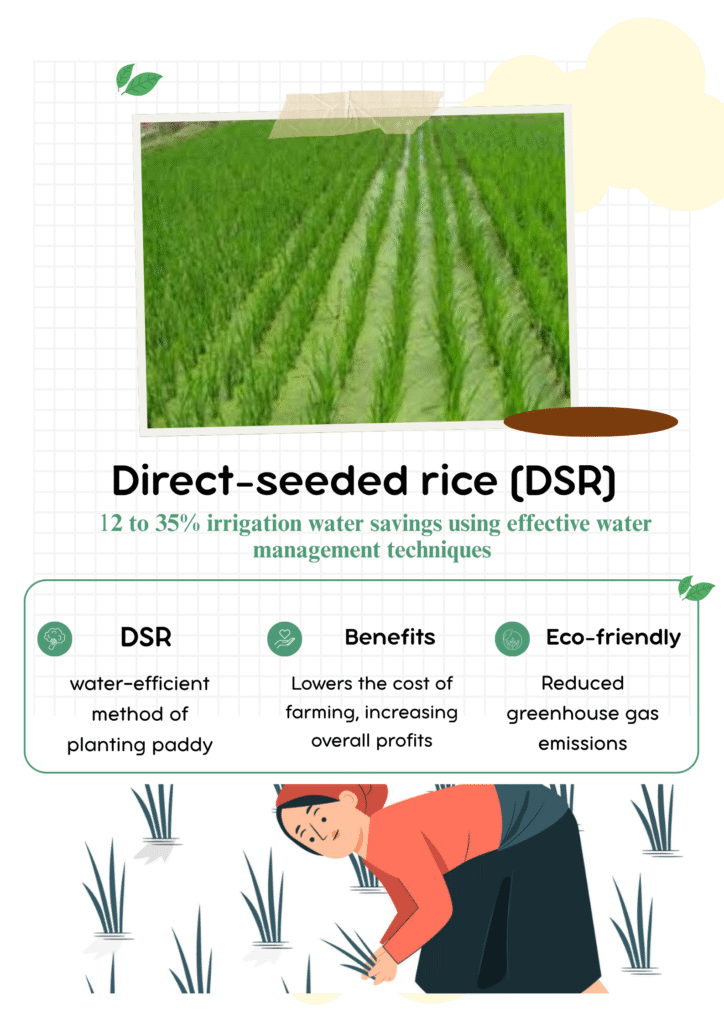
It is a water-efficient method of planting paddy. DSR is also known as the “broadcasting seed technique.” Using this method, seeds are drilled directly into the fields. The DSR technique conserves groundwater in the conventional, water-intensive process of moving rice seedlings from a nursery to flooded fields. This procedure does not require transplantation or nursery preparation. Only one pre-sowing irrigation and field leveling are required of farmers.
Direct seeding benefits:
- No appreciable decrease in yield under ideal circumstances
- 12–35% irrigation water savings using effective water management techniques
- Eliminates the need to remove and transplant seedlings, which saves time and effort.
- Reduces the time, expense, and effort required to grow.
- Plant stress from transplanting is absent.
- Quicker crop maturity
- Reduced greenhouse gas emissions
- Mechanized DSR uses a service-providing business model to give young people job opportunities.
- lowers the cost of farming, increasing overall profits.
Method of DSR:
Direct seeding can be accomplished in two different ways, depending on the kind of land preparation that is utilized:
- Direct Dry Seeding of Rice.
- Wet seed direct seeding of rice.
A) Direct Dry Seeding of Rice:
Farmers typically use this method in rainfed and deepwater ecosystems, where they sow the seed on the dry soil surface and then incorporate it through plowing or harrowing.
Broadcasting of rice seeds:
Sow 25-35 kg of seeds evenly across a 1-acre field, either by hand or in furrows. Using a furrower, create shallow furrows in the prepared field. Spread the seeds, then use a spike-tooth harrow to cover them.
Drilling of Rice Seeds
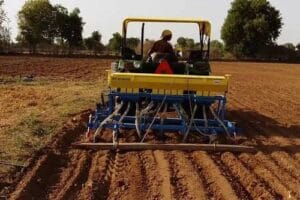 Precision equipment, such as the Turbo Happy Seeder, can be used to drill seed. Drill 35–42 kg of seeds per acre. The machine places seeds in dry and damp soil and then irrigates them. Seeds should not be sown deeper than 10-15 mm on a smooth, flat seedbed. This procedure enables the addition of nutrients to the seed. Additionally, machine-drilled crops are simpler to weed than broadcast crops.
Precision equipment, such as the Turbo Happy Seeder, can be used to drill seed. Drill 35–42 kg of seeds per acre. The machine places seeds in dry and damp soil and then irrigates them. Seeds should not be sown deeper than 10-15 mm on a smooth, flat seedbed. This procedure enables the addition of nutrients to the seed. Additionally, machine-drilled crops are simpler to weed than broadcast crops.
1) Dibbling of Rice Seeds;
a) Broadcasting of Rice Seed
- On steep slopes or in situations where plowing and harrowing are challenging, dibbling or hill planting is sometimes employed. To dig holes, use a long bamboo or wooden pole with a metal scoop connected at the end. After placing the seeds in the holes, cover them with soil.
b) Drum seeding of Rice
- For efficient planting, drum seeders require a well-leveled, smooth, and wet seedbed. However, seeders may be blocked if the machine is poorly built or the soil is sticky.
B) Wet seed direct seeding of rice;
Broadcasting or drilling seeds into the mud with a drum seeder are two methods for direct sowing in wet fields.
A) Broadcasting:
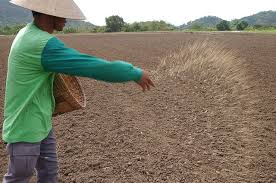 Disperse 35–42 kg of pre-germinated seeds per acre into shallow standing water or well-puddled seedbeds that have just been drained. Before broadcasting, give the field’s muddy water a day or two to dry. If the fields’ water is drained after broadcasting, seeds are reintroduced 10 to 15 days after initial seeding.
Disperse 35–42 kg of pre-germinated seeds per acre into shallow standing water or well-puddled seedbeds that have just been drained. Before broadcasting, give the field’s muddy water a day or two to dry. If the fields’ water is drained after broadcasting, seeds are reintroduced 10 to 15 days after initial seeding.
B) Direct-seeding-planting-drum seeder;
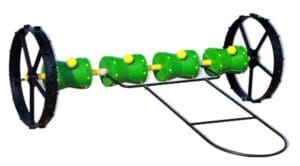 Seeding with drum seeders is used for quick planting. Smooth, level, and wet seedbeds are ideal for them. However, if the soil is sticky or the equipment is poorly built, the seeders may become blocked. Prepare 35 kg of pre-germinated seeds for each acre.
Seeding with drum seeders is used for quick planting. Smooth, level, and wet seedbeds are ideal for them. However, if the soil is sticky or the equipment is poorly built, the seeders may become blocked. Prepare 35 kg of pre-germinated seeds for each acre.

